Accurately Gauge the Influence of Individual Marketing Channels on Conversions
A typical B2B sales cycle involves a very high number of touchpoints and the entire process from prospecting to conversion spans many months. Customers try to gather a lot of information about a company before purchasing and in the process, they go through a variety of marketing channels. The sales cycle is also longer because of the extended purchase cycle that is internal to the customer. In this scenario, companies should better understand conversion and the influence of each marketing channel on lead generation and conversion. Knowledge of which channels the customer is using and the significant touchpoints which influence the customer are vital. Until this is understood, companies may continue to invest in too many marketing channels. Not only does this incur wasteful expenditure, but also it demands time and energy from the management team. B2B Attribution Modelling gives the contribution of each customer touchpoint to the overall revenue. It helps cut down on unnecessary marketing channels and helps you focus on what is actually working.
Leverage Attribution Modelling to Optimize Marketing Strategy and Gain Competitive Advantage
Attribution modelling in B2B results in the following benefits:
- Gain insights into customer decision cycles and accordingly align your marketing strategy.
- Identify efficient conversion paths by analyzing different customer journeys and comparing key metrics such as the number of leads generated over time and the cost per lead.
- Identify and scale down on poorly performing marketing channels for bottom-line savings.
- Measure the effectiveness of different campaigns (within each channel) and suitably decipher better performing campaign strategy.
Understanding the B2B Attribution Modelling Scenario
Here’s what makes B2B attribution modelling challenging:
- The length of the conversion funnel
- The number of interactions and
- The combination of online and offline touchpoints
On an average, B2B buyers engage 36 times with their vendors before purchasing and the journey could possibly involve many touchpoints. Capturing these data points accurately and extracting patterns from them is one of the biggest tasks of attribution modelling.
The following is a representation of a typical B2B customer journey comprising the various stages in marketing and sales:
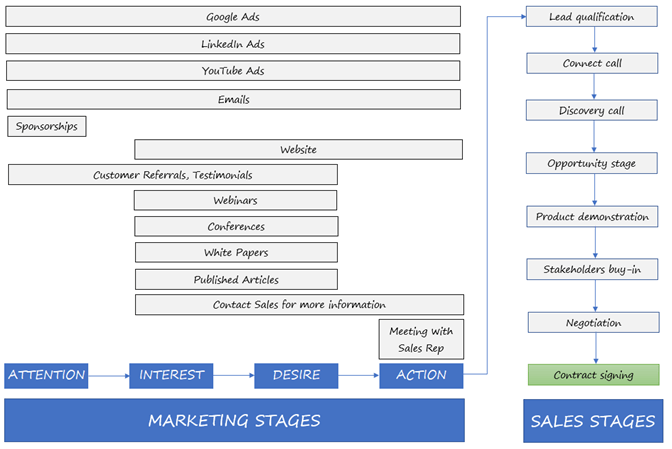
- In B2B, unlike in B2C, the person who researches for the product may not be the end user. Today, approximately 7 people are involved in a B2B purchase. They can be of the following types:
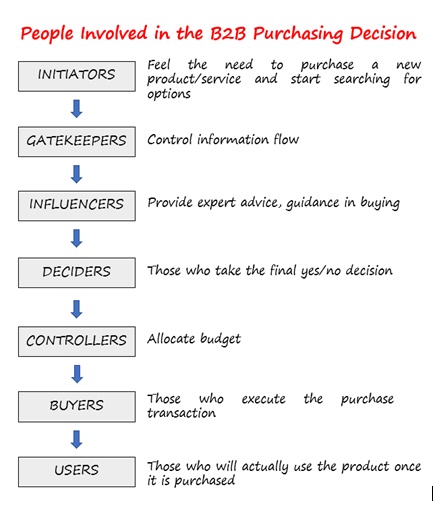
Different people from the above list can reach out to the company via any touchpoint.
The journey to conversion is very time-consuming and usually spans many months. The following is a representative image of multiple paths taken by customers in their journey:
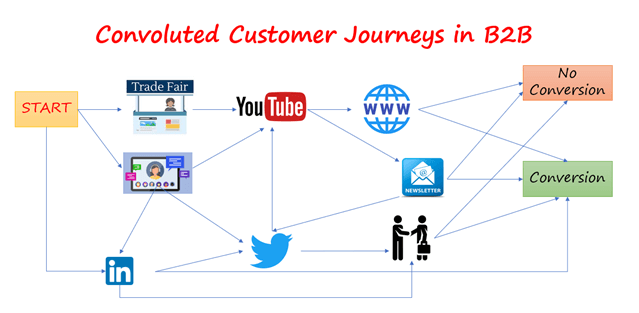
The other factor is that interactions could be online as well as offline. For example, a prospective buyer may meet the company’s sales representative at a booth in a trade show, get the brochure and check out the company’s website the next week.
Therefore, B2B marketing attribution involves omnichannel attribution i.e., the integration of online (clickstream data) as well as offline (typically stored in CRM) interaction data.
Tackle Challenges in B2B Marketing Attribution Using Advanced Models
Due to the above-mentioned factors, building an attribution model in B2B is a lot more complicated than it is in B2C. Conventional heuristic models such as the first or last click models, the linear attribution model etc. are not suitable in B2B. The correct class of model is an algorithmic multi-touch model that gives appropriate credit to every piece of content/channel that a prospect interacts with.
When it comes to building custom models for B2B marketing attribution, the Markov Chain model and the Shapley Value model are the most-commonly used.
The main reason is that these models are multi-touch models capable of attributing conversions to multiple touchpoints based on the touchpoints’ actual influence on the conversions with reasonable accuracy. This overcomes the handicap of heuristic models such as the first/last touch models which attribute conversion to just one channel. Also, these models are scalable i.e., they can accommodate a high number of touchpoints which is typically the case with B2B customer journeys.
The Markov Chain Model for B2B Marketing Attribution
The Markov Chain is a random process where a system is modelled as a series of states. At any point in time, the system can transition from one state to another and there is a probability associated with each of these transitions. The different channels that a customer goes through in the marketing and sales stages are the ‘states’ of the Markov Chain model.
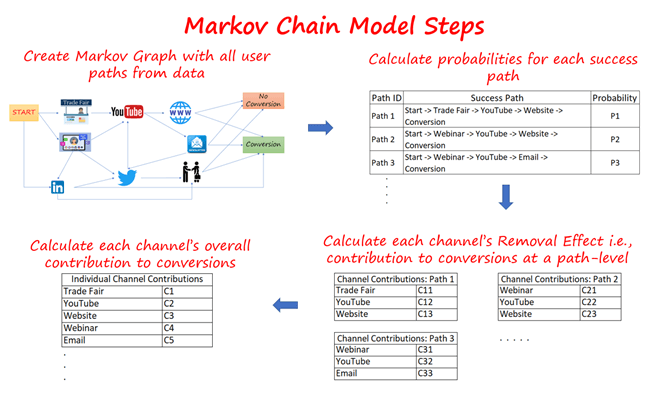
In the attribution modelling scenario, the prospect transitions from one marketing/sales channel or stage to another and ultimately converts or does not convert. Using clickstream and CRM data, the probabilities of these transitions and conversion can be calculated, thereby allowing us to apply the Markov Chain model to the scenario.
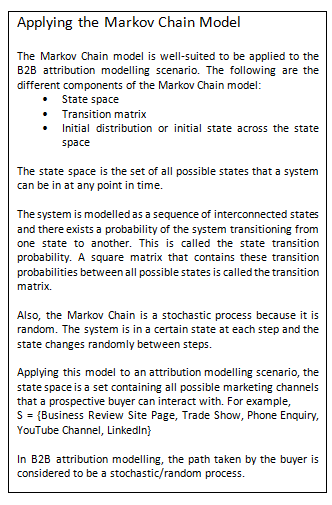 This model is one of the most-widely used ones for attribution modelling because of its scalability – it is very efficient when being applied to both large as well as small datasets. It also requires very less computing power. Therefore, even if the customer journey involves numerous touchpoints, the performance of the model will not be compromised. It is also much less sensitive to random data.
This model is one of the most-widely used ones for attribution modelling because of its scalability – it is very efficient when being applied to both large as well as small datasets. It also requires very less computing power. Therefore, even if the customer journey involves numerous touchpoints, the performance of the model will not be compromised. It is also much less sensitive to random data.
By integrating CRM data and clickstream data (for offline and online interactions respectively), we first draw a Markov graph which contains all the different paths taken by all customers. Also, these data will give us the number of customers entering and exiting each stage of the sales process. Using these numbers, we can calculate the state transition probabilities.
From the transition probabilities obtained as described above, we can calculate the removal effect of each channel i.e. the difference in the probability of conversion when that channel is removed from the Markov Chain.
The Removal Effect is the conversion contribution of a channel in a particular path. When this measure is aggregated across all paths, we get the overall conversion contribution of each channel.
Removal Effect of Channel (C) = (Probability of conversion with C) – (Probability of conversion without C)
This way, the removal effect of each channel is calculated and the share of conversions is attributed accordingly to the corresponding channel.
By calculating the number of conversions associated with each channel and using the available data on the advertising spend in that channel, we can identify which channel(s) is/are responsible for conversions and calculate the efficiency of each channel by calculating the cost per conversion.
The Shapley Value Model for B2B Marketing Attribution
Consider a game with multiple players. The contribution of each player to the end result of the game will be different. The Shapley Value model equitably distributes payoffs of a game among players who may have unequal contribution to the payoff.
Applying the Shapley Value model to B2B Attribution Modelling, the different marketing channels are considered to be players and the revenue or conversions are considered as the payoffs.
There are distinct advantages while using the Shapley Value model. Certain marketing channels can hurt conversions – this is captured by negative Shapley values. Also, the Shapley Value model is better at detecting click spam i.e., interactions with no incremental effect on conversions.
In the B2B attribution modelling scenario, we consider each marketing channel to be a player and the interactions/pathways between the channels to be coalitions. We also represent the total revenue generated or the total number of conversions as the characteristic function.
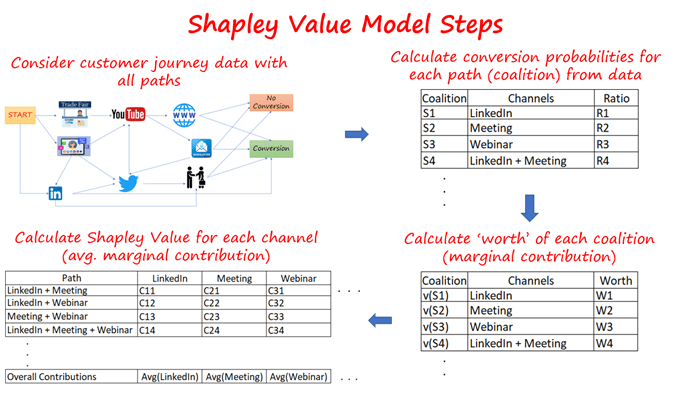
We measure the conversion ratio for each channel and coalition i.e., combination of channels. Then we calculate the ‘worth’ of each coalition by summing up the conversion ratios of all the channels in that coalition. Using these ‘worth’ values, we calculate the Shapley Value for each channel as the average of each channel’s marginal contribution.
Adding these average values for all the channels will yield a value of 1 i.e., 100%. Therefore, the Shapley Value for each channel represents that channel’s percentage contribution to the total revenue or the total conversions.
Achieve Measurable Growth by Leveraging Data and Deploying the Right Solution
Though B2B Attribution Modelling is different from that in B2C, by collecting and integrating the necessary data points and using advanced models, we can attribute conversions and revenue to the right marketing channels. These models can be deployed in production and can be automated to run at specified periods of time as required. The biggest advantage of applying an advanced model for B2B attribution is the quantification that it provides. We can view ad expenditure in the context of lead generation and conversions of different marketing channels. Stakeholders can analyze customer journeys, identify the relative importance of each path and build meaningful customer experiences. By gaining insight into customer behaviour and significant touchpoints, they can make better investment decisions.
References
- Mapping the customer journey: A graph-based framework for online attribution modelling; Eva Anderl, Ingo Becker, Florian v. Wangenheim, Jan H. Schumann (https://papers.ssrn.com/sol3/papers.cfm?abstract_id=2343077)
- Mining Advertiser-Specific User Behaviour Using Adfactors; Nikolay Archak, Vahab S. Mirrokni, S. Muthukrishnan (http://pages.stern.nyu.edu/~narchak/wfp0828-archak.pdf)
- Media Exposure through the Funnel: A Model of Multi-Stage Attribution; Vibhanshu Abhishek, Peter S. Fader, Kartik Hosanagar (https://papers.ssrn.com/sol3/papers.cfm?abstract_id=2158421)
- Attribution Modelling of Online Advertising; Syed Rizvi. (https://trepo.tuni.fi/bitstream/handle/10024/115941/RizviMustufain.pdf?sequence=2)
- Markov Chains: Compact Lecture Notes and Exercises; ACC Coolen. (https://nms.kcl.ac.uk/ton.coolen/allnotes/MarkovChains.pdf)
- Some game theoretic marketing attribution models; Elisenda Molina, Juan Tejada, Tom Weiss. (https://www.researchgate.net/publication/346578469_Some_game_theoretic_marketing_attribution_models)
- Data-Driven Marketing Attribution: Custom Attribution with Cooperative Game Theory; James Kinley. (https://towardsdatascience.com/data-driven-marketing-attribution-1a28d2e613a0)
The New Sales Imperative; Nicholas Toman, Brent Adamson and Cristina Gomez, Harvard Business Review. (https://hbr.org/2017/03/the-new-sales-imperative
